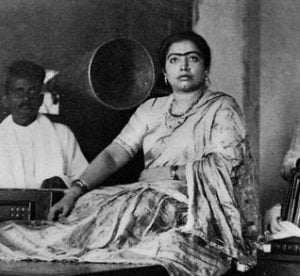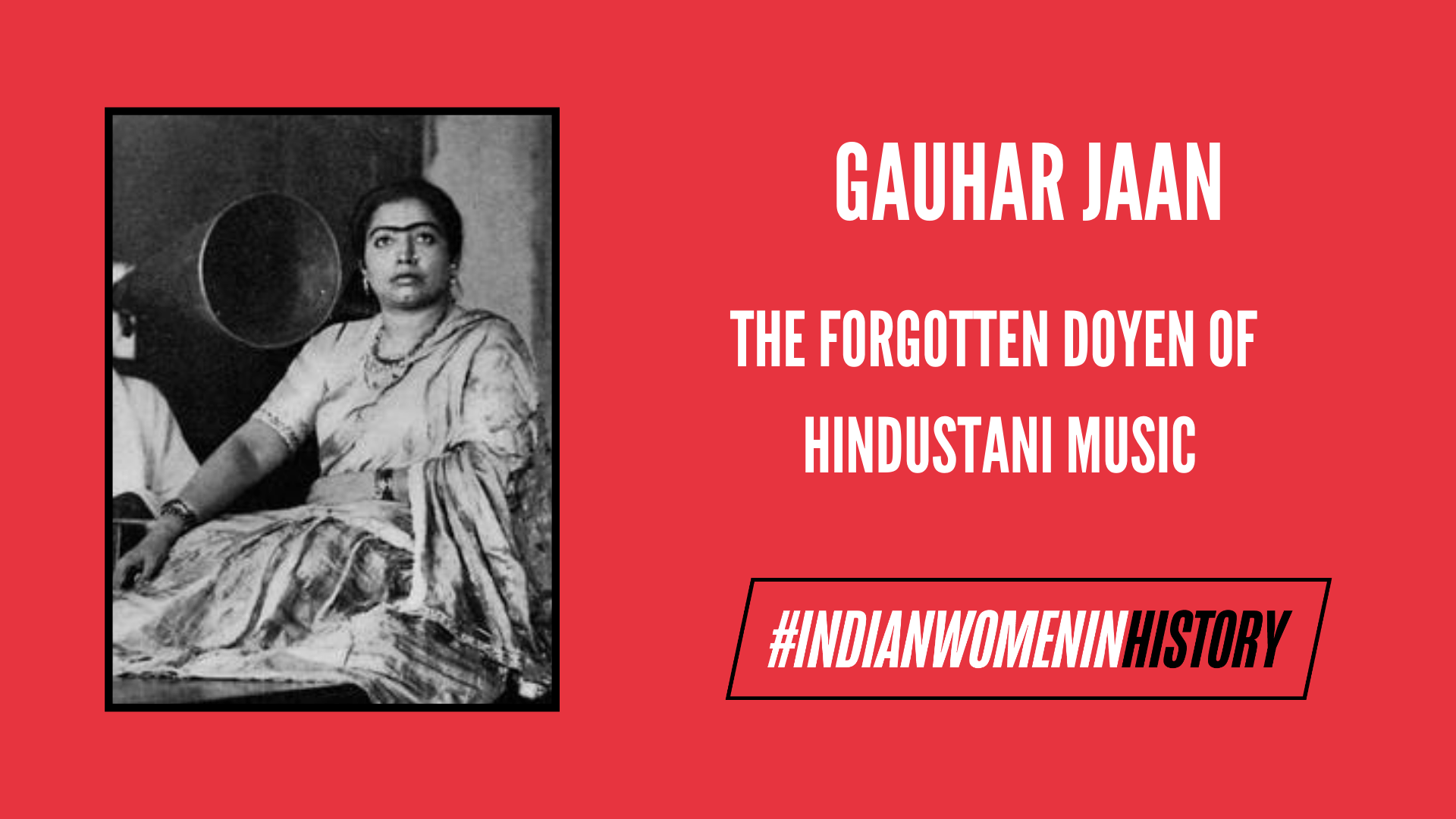A feisty woman always embellished in lavish outfits, Gauhar Jaan was a musician par-excellence who popularised different forms of Hindustani music and lived life on her own terms. Bestowed with numerous titles and accolades by the Royal Courts as well as the British Government, Gauhar Jaan was the most sought after artist during the pre-independence era. Her remarkable journey from a being a tawaif’s (a professional courtesan serving the nobility, especially under the Mughal Empire) daughter in the city of Banaras to a well known ‘Gramophone Girl’ is indeed a repository of fame, glory and skylarking success.
Her legacy, however, remains only on uncharted official papers and informal letters. Her name, lost in the forgotten tales of South Asian history. However, various journalists, artists and musicians have come forward to revive her musical journey and life history in their books, articles and papers.

Image Credit: Wikipedia
Early Life
Gauhar Jaan was born as Eileen Angelina Yeoward in Azamgarh (which was then the United Provinces) in 1873. She was an embodiment of secular ethos that Indian classical music is known for – her grandmother was Hindu, grandfather British, and father an Armenian Christian. She later embraced Islam and remained a devoted Muslim all her life, though most of her compositions are about Krishna Bhakti and other tales of Bhakti tradition.
Gauhar Jaan’s parents separated when she was around six years old after which she (along with her mother) moved to Banaras. Her mother, Victoria Yeoward converted to Islam and thus took on the name of ‘Badi Malka Jaan’. She was a popular kathak courtesan and was known for her dancing prowess. Thus Gauhar’s innate talents in dance, music and literature flourished in a culturally vibrant city of Banaras.
Subsequently they moved to Calcutta and established themselves in the court of Nawab Wajid Ali Shah who himself was an excellent musician and lyricist. At 14, Gauhar Jaan gave her first ever musical performance at the royal courts of Darbhanga Raj (Bihar). Her exquisite performance made her popular across the rulers of Maithil dynasty who invited her repeatedly to their royal courts. She was fondly called ‘Gauhar Jaan Kalkattewaali’ by her followers.
Musical Journey
In her illustrious musical journey, she recorded upto 600 songs in over 10 languages including English, French and Pashto. She did not restrict herself to one form of song and was equally skilled in Dhrupad as well as in thumri, dadra, kajri, hori, tarana, rabindra sangeet and bhajan. Her famous thumri – ‘Raske Bhare Tore Nain’ continues to amaze with her melancholic melodies of the ancient composition (set to Raag Bhairavi).
‘The Gramophone Girl’
In 1902, the British Gramophone company was on a six-week-long exercise of recording music of the local artists. The American sound engineer Fred Gaisberg gave Gauhar Jaan the opportunity to record for their 78 rpm disc and thus, she became the first recording artist in the subcontinent and was bestowed with the title – ‘The Gramophone Girl’.
While the established men in Hindustani classical music despised the technological intervention in the field of music, it was the tawaifs and courtesans who came forward to accept it with open arms. “It not only helped democratise music and bring it out the from the four walls of the salons and courts, but also liberated these women artists from the clutches of their exploitative patrons,” says Vikram Sampath, author of the book ‘My Name is Gauhar Jaan!: The Life and Times of a Musician’.
In order to consolidate an hour long khyaal to a 3 minute recording for the 78 rpm disc, she invented a unique style of presenting an expansive khyaal into a short time-span. For her very first recording, she decided to sing Raag Jogiya and it blossomed in high octaves. The resulting record came out vibrant and also had an emotional touch. Her recordings would always end with a high-pitched announcement “My name is Gauhar Jaan!”. Sampath talks about the necessity of such an announcement as the records were sent to Hanover (Germany) for pressing and the announcement helped the engineers identify the singer.
She was criticised by the contemporary musicians for disregarding the depth and expanse of khyaal music by reducing it to a 3 minute record. However, she remained unaffected by them and instead started off a new style of presentation. This was subsequently implemented by various musicians including Ustad Amjad Ali Khan (a famous sarod player) who released various short spanned items in his albums. He talks about the significance and beauty of consolidation of Raagas in his book ‘Masters on Masters’ while referring to Gauhar Jaan’s unique style of music.
Lavish Lifestyle
Her feisty nature and bold attitude set her apart from her contemporaries. She would always dress up in embroidered sarees and heavy jewellery and was no less than a royal queen. She became infamous for arranging a lavish party of worth 20,000 rupees when her cat produced a litter of kittens. However, she had no qualms about her rising notoriety and embraced her success unapologetically.
She would flout the government regulations in Kolkata and would go around in her four-horse-driven buggy, for which she even paid a fine of 1,000 rupees a day to the viceroy. She made around 3,000 to 4,000 rupees per recording which was really high during that time. Despite getting government orders asking her to stop violating the rules, she continued living her life the way she wanted to. She gained a celebrity status that few women of her era could even dream of.
Dark Times and Tragic Death
Gauhar Jaan’s high profile status and expensive lifestyle dwindled as she got caught up in legal battle with her secretary Abbas who had married her only for her wealth. Most of her wealth was drained off in many legal battles during the last few days of her life. Moreover, she also faced sexual harassment while she was a courtesan and had to overcome it all to emerge as the doyen of Hindustani music.
While she was in Mysore, she was invited by Maharaja Nalvadi Krishnaraja Wodeyar as a state guest and court musician. By then, she had lost the will and strength and in 1930, she took her last breathe lonely and impoverished with no one by her bedside. This further lead to the demise of her identity. Today, she is remembered as one of those lost and forgotten artists of the past.
In the past few years, some scholars like Vikram Sampath, Mrinal Pande, Chaitali Roy have taken upon themselves to revive her forgotten legacy but her legacy still remains largely unexplored. While alive, she not only challenged the authorities of the time but also intermeshed technology with Hindustani classical music which later helped in recording albums and archiving lost compositions. She redefined music and therefore must be remembered by all across generations.
Also read in Hindi: गौहर जान: ‘भारत की पहली रिकॉर्डिंग सुपरस्टार’ | #IndianWomenInHistory
About the author(s)
Tanya is a post-graduate in Media Studies from Centre for Culture, Media and Governance at Jamia Milia Islamia. She is passionate about music, cinema and lots of street food.




